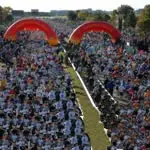
The Marine Corps Marathon is a fall highlight for thousands of runners every year. The timing is perfect for conditions, the course is predominantly flat, and the on-course motivation is quite high. Despite this, thousands of runners fail to meet their pre-race goals...and we want to fix that.
In this post we'll cover a hybrid model of pacing, one that merges the Marathon Nation approach of conservative early miles with a model that accounts for the terrain of the Marine Corps Marathon. Our goal is to set you up with a pacing plan that will help you make the most of your fitness and help you have the day you have earned.
Step One: Understanding Race Execution
Race execution is the understanding that, while each of us may have our own strategy on race day, there are certain ways to run that can create the conditions for your success. It's a framework, a starting point. Whether you achieve your goals is then a function of your personal strategy, your fitness, how you handle race day challenges, etc. As experienced marathoners can attest, there's a right way and a wrong way to run on marathon race day. In other words, the fittest person isn't automatically the fastest.The Marathon Nation Race Approach
Here's how we break it down inside Marathon Nation:
Start Smart (Miles 0 to 5): Given your goal pace of, say 9:00/miles, you purposely start off slower by about 15 seconds per mile. Then you start to bring the pace down such that by mile 5, you are running at or just under your goal pace. It sounds crazy, for sure, but it means you aren't running too hard, or wasting energy trying to weave around the competition. You are just in your zone, slowly building up your pace to where you'll want it to sit all day.
Run to the Line (Miles 6 to 20): The bulk of your race is spent running just under our goal pace. For our 9 minute/mile runner, this means miles in the 8:55-minute range. The purpose here is to be consistent but to slowly chip away at the timing surplus that our early conservative pacing created. By the time we reach the end of this section of our day, you should be right on target for your goal time but in a much better place.
The Line (aka the "wall") is the part of your race day where your body begins to push back. In general this happens between miles 18 and 22 on race day, depending on the course, your pacing, your fitness, etc. Many runners go out fast putting time in to "the bank" for when they slow down, but the time saved will mostly likely be nowhere near sufficient to staunch the bleeding at the end of your day.
Until you hit the "line" you aren't racing, you are running. You ignore the other runners and do your best to flatten out the course through smart pacing. Nutritionally you are fueling in anticipation of the last six miles.
Race to the Finish (Miles 21 to Finish): The last six miles on race day are where dreams are made (or broken). Inside Marathon Nation we don't dread the end of the race; it's where our day begins. If you have paced yourself properly, you'll just be starting to pass other runners as everyone around you is slowing down. This is not only a judicious application of your fitness, it's a powerful mental strategy that helps you stay focused just as your body is trying to check out.
In summary, the basic Marathon Nation Pacing approach is:
- Give away 15 seconds per mile for first six miles.
- Gain back 5 seconds per mile from miles 6 through 20.
- Last 10K is on pace.
Step Two: The Marine Corps Marathon Course
This course is unique for several reasons. First, it has some early hills and crowding which can really mess with your pacing plan. Second, it's a loop course which means that you get a higher percent of spectators and you will know what the course will be like—especially for all the return trips. Third, it's got a loop of Haines Point, a flat and open peninsula opposite the Lincoln Memorial that is totally exposed to winds off of the Potomac. Anyone who lives close enough to train on the course regularly will tell you the winds here can be as bad as the hills of Newton can affect your Boston performance. Fourth, there is the challenging last mile...OK it's really a slight uphill over the last 3 miles. But the last mile is the hardest for sure. If you have any cracks in your fitness at this point, your goal time will most certainly fall by the wayside. And let's not talk about the crowding at the finish line and just how cold it can get there. Ask any finisher and they'll tell you they remember being freezing after they hit the finish line.
Please Note: This pacing model is what MN Member William Jenks used to put up a PR performance in the 2010 Boston Marathon. You can download and listen to the full interview from the web.
- 1
- of
- 2
Get ACTIVE on the Go


Couch to 5K®
The best way to get new runners off the couch and across the finish line of their first 5K.
Available for iOS | Android








Discuss This Article